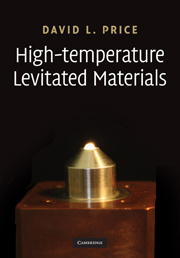3 - Heating methods
Published online by Cambridge University Press: 23 April 2010
Summary
Laser heating
Carbon dioxide (CO2) infrared lasers provide a natural choice of heating system in conjunction with aerodynamic levitation. For the CNL setup shown in Fig. 2.1, a Synrad Model 60–2 270-W cw CO2 laser in the infrared range is used to heat and melt the samples. The laser beam is tilted with respect to the vertical plane by approximately 15° to avoid interference with the motion of the X-ray detector. It is directed at the sample by means of two mirrors and a ZnSe lens placed between them. Two controllers, one located inside the X-ray hutch and the other outside it, were used to control the laser power independently.
Heating with a single laser leads to significant temperature gradients, especially with insulating samples. More recent setups (Krishnan et al., 2005; Hennet et al., 2006) incorporate a second laser heating the sample from below through a small hole in the conical nozzle in order to reduce these gradients. In the CRMHT apparatus, there are actually two lasers heating the sample from above. At the lowest specimen temperatures, the power delivered to the specimen from below is roughly equal to the power delivered from above. With these modifications, temperature gradients from top to bottom of the sample are expected to be reduced below 25 °C, even for oxide samples.
Laser heating, generally with one or two CO2 infrared lasers, is also used in recent high-temperature experiments with electrostatic levitation.
- Type
- Chapter
- Information
- High-Temperature Levitated Materials , pp. 23 - 27Publisher: Cambridge University PressPrint publication year: 2010

